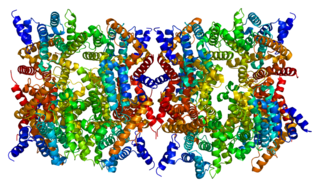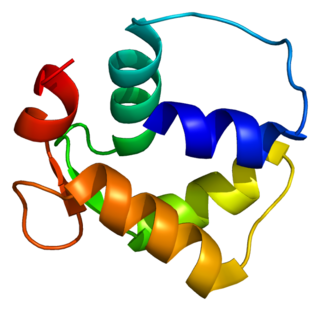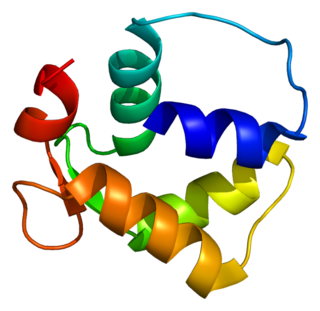The Olduvai domain, known until 2018 as DUF1220 and the NBPF repeat, is a protein domain that shows a striking human lineage-specific (HLS) increase in copy number and appears to be involved in human brain evolution. The protein domain has also been linked to several neurogenetic disorders such as schizophrenia and increased severity of autism. In 2018, it was named by its discoverers after Olduvai Gorge in Tanzania, one of the most important archaeological sites for early humans, to reflect data indicating its role in human brain size and evolution.

cAMP-specific 3',5'-cyclic phosphodiesterase 4D is an enzyme that in humans is encoded by the PDE4D gene.

Centrin-2 is a protein that in humans is encoded by the CETN2 gene. It belongs to the centrin family of proteins.

A-kinase anchor protein 9 is a protein that in humans is encoded by the AKAP9 gene. AKAP9 is also known as Centrosome- and Golgi-localized protein kinase N-associated protein (CG-NAP) or AKAP350 or AKAP450

Alpha-centractin (yeast) or ARP1 is a protein that in humans is encoded by the ACTR1A gene.

Ninein is a protein that in humans is encoded by the NIN gene.

Centromere protein J is a protein that in humans is encoded by the CENPJ gene. It is also known as centrosomal P4.1-associated protein (CPAP). During cell division, this protein plays a structural role in the maintenance of centrosome integrity and normal spindle morphology, and it is involved in microtubule disassembly at the centrosome. This protein can function as a transcriptional coactivator in the Stat5 signaling pathway and also as a coactivator of NF-kappaB-mediated transcription, likely via its interaction with the coactivator p300/CREB-binding protein.

Golgin subfamily A member 3 is a protein that in humans is encoded by the GOLGA3 gene.

Centrosome-associated protein 350 is a protein that in humans is encoded by the CEP350 gene.

CDK5 regulatory subunit-associated protein 2 is a protein that in humans is encoded by the CDK5RAP2 gene. It has necessary roles in the formation and stability of microtubules from the centrosome and has been found to be linked to human brain size variation in males. Multiple transcript variants exist for this gene, but the full-length nature of only two has been determined.

Katanin p80 WD40-containing subunit B1 is a protein that in humans is encoded by the KATNB1 gene.

Neuroblastoma breakpoint family, member 3, also known as NBPF3, is a human gene of the neuroblastoma breakpoint family, which resides on chromosome 1 of the human genome. NBPF3 is located at 1p36.12, immediately upstream of genes ALPL and RAP1GAP.

Centrosomal protein 170kDa, also known as CEP170, is a protein that in humans is encoded by the CEP170 gene.

Centrin-1 is a protein that in humans is encoded by the CETN1 gene. It belongs to the centrin family of proteins.

Centrosomal protein of 70 kDa is a protein that in humans is encoded by the CEP70 gene. The protein interacts with γ-tubulin through its coiled coil domains to localize at the centrosome. CEP70 is involved in organizing microtubules in interphase cells and is required for proper organization and orientation of the mitotic spindle.

Centrosomal protein of 192 kDa, also known as Cep192, is a protein that in humans is encoded by the CEP192 gene. It is the homolog of the C. elegans and D. melanogaster gene SPD-2.

Neuroblastoma breakpoint family member 10 is a protein that in Homo sapiens is encoded by the NBPF10 gene.

Protein Hook homolog 2 (HK2) is a protein that in humans is encoded by the HOOK2 gene.

Neuroblastoma breakpoint family, member 1, or NBPF1, is a protein that is encoded by the gene NBPF1 in humans. This protein is member of the neuroblastoma breakpoint family of proteins, a group of proteins that are thought to be involved in the development of the nervous system.
The neuroblastoma breaking point family (NBPF) is a family of genes involved in neuronal development. The family is highly specific to primates, with minimal similarity or presence in other mammals and no presence in other animals, and its genes' content has been subject to a very high number of duplications in humans. It was described by Vandepoele et al. in 2005 and named as such because NBPF1 was found to be broken by a chromosomal translocation in a neuroblastoma patient.


















